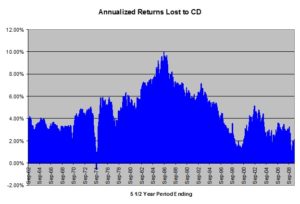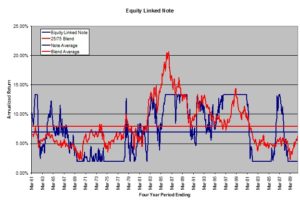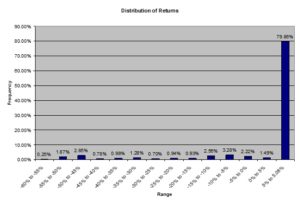An asset class is a group of investments that have similar behavior and characteristics. When selecting investments it is vitally important to have estimates of three statistics for each asset class:
- Expected Return – the rate of return anticipated on average.
- Standard Deviation – the variability likely in those returns.
- Correlation Coefficient – the manner in which two classes move relative to each other.
Very safe investments tend to have very low returns and very low chances of much volatility in those returns. More speculative investments tend to have both higher average returns and a higher chance that actual experience will be vastly different from that average. The third factor, correlation, is extremely important but frequently overlooked. With investments that move in different directions from each other, the portfolio will have a lower standard deviation of returns than its components. This is the rare case of a free lunch – diversification works.
We believe there are only two primary asset classes – stocks (equity) and bonds (debt). There is overwhelming evidence that the primary determinant of gross portfolio performance will be the portfolio allocation between these two classes. Net performance can be greatly enhanced by accessing these classes efficiently, though this is not often done. Within these two main categories, a number of sub-classes, while they may be useful, are vastly less important than getting the “big picture” right. The precise sub-classes used and the level of use will vary by client. Following are some typical subdivisions:
Equities (Stocks). Some exposure to stocks is the only way most people can reach their financial goals. We believe the risk of a portfolio losing money in a given year is far less important than the risk that the portfolio won’t last as long its owner. The following are common ways to classify stocks:
- Geographic location: Domestic, Foreign, Emerging Markets, Frontier Markets. We believe foreign exposure may reduce portfolio volatility, but investors frequently prefer low exposures to foreign companies and are willing to endure potentially higher volatility to be more aligned with domestic markets.
- Market capitalization (size): Micro Cap, Small Cap, Mid Cap, Large Cap. Though it appears smaller companies may perform better than their larger brethren over long periods of time, the effect seems less pronounced now than it once was and may not exist at all after adjusting for the higher risk level. Because of the often high transaction costs with these smaller companies, it is important to get exposure to them as efficiently as possible.
- Valuation: Growth, Value. A fair amount of academic research indicates that value stocks have higher returns and lower volatility over time. This appears to be true because investors irrationally prefer growth stocks and therefore systematically misprice growth vs. value investments. This effect appears to be larger for smaller companies. For this reason we tend to tilt portfolios toward value in general and small value in particular.
Fixed Income (Bonds). We believe the primary function of bonds in a portfolio is to reduce risk. For this reason we do not attempt to seek out incremental returns by adding risk in this area. We believe that if you need higher returns, the appropriate approach is increasing equity exposure rather than attempting to get higher returns from the fixed income portion of the portfolio.
- Duration: This sophisticated measure incorporates the magnitude, timing, and discounting of future cash flows to give a measure of volatility. It is related to, though not synonymous with, the more familiar “maturity.” Because we believe the purpose of the bond allocation is to reduce risk, we have a large bias toward short duration instruments. Long duration fixed- income investments have higher volatility levels but not commensurately higher returns. At the other extreme, the shortest duration is simply a cash equivalent.
- Taxability: Some fixed-income instruments (Municipal Bonds or “Muni’s”) are tax free. We tend not to use these investments much because 1) marginal rates appear to be in a long-term (not short-term) declining trend, 2) bonds are optimally held in tax-advantaged accounts, 3) Muni’s only make sense for taxpayers in the highest tax brackets, and 4) they are riskier than U.S. Government bonds. However, for high tax bracket investors without the “room” in their tax-advantaged accounts to accommodate their fixed income holdings Munis can make sense as a portion of the fixed income holdings.
- Credit Quality: High Yield, Corporate, Agency, Treasury. We strongly advocate only investment grade bonds in the fixed income allocation of the portfolio and therefore consider High Yield (aka “junk”, “non-investment grade”, or “speculative bonds”) to be inappropriate.
- Inflation Protection: Treasury Inflation Protected Securities (TIPS) are a relatively recent innovation (1997) with no appreciable credit risk or inflation risk. We generally use these instruments in significant quantities.
This has been a much abbreviated and simplified overview of the two primary asset classes and some of the sub-classifications you will frequently see, but so-called “alternative” investments are becoming increasingly popular. My next post will delve into those areas.


